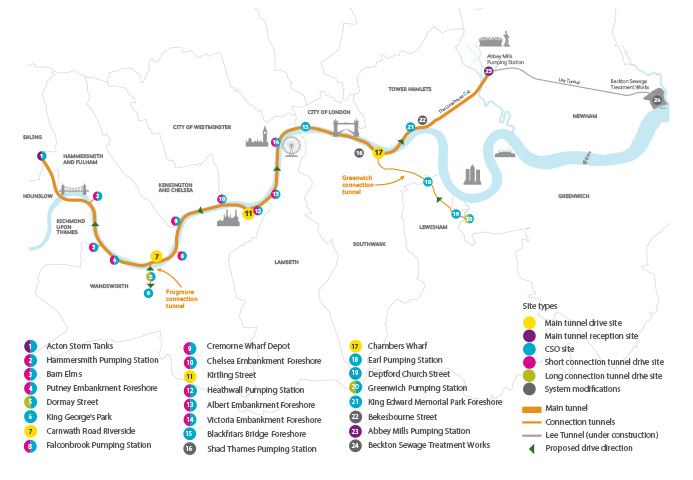Public sewer

|
| The Thames tideway tunnel comprises a 24km long 7.2m diameter sewer running from Acton in the west to Abbey Mills in the east. It will have a holding storage capacity of 1.6 million cubic metres. |
A pipe that serves only one property is referred to as a drain. Drains are privately owned and maintained as far as the boundary of the property. Beyond the boundary of the property a drain is referred to as a public lateral drain.
A pipe that serves more than one property is referred to as a sewer. Sewers that connect to the public sewer network are referred to as public sewers.
The sewer system, that is, the underground network of pipes that carries sewage (waste water and excrement), other waste water and surface water run-off, from properties to treatment facilities or other disposal points is referred to as sewerage.
Under the Public Health Act 1936 all sewers (as defined by the Public Health Act 1875) which were in existence on 1 October 1937 became public sewers. After 1937 new sewers were only public if they were laid or adopted by the sewerage undertaker.
However, on 1 October 2011 in England and Wales, private sewers and lateral drains that were connected to the public sewer before 1 July 2011 were transferred to the ownership of the regulated sewerage companies (generally water companies).
It is possible to apply for new or existing sewers or lateral drains to be adopted by a sewerage company. For more information see:
Public sewers usually run under roads or public open spaces, but they may also run through private property such as gardens. The sewerage company has a right of access to these public sewers in order to maintain them.
Permission is required from the sewerage company to build over a public sewer. Failure to obtain permission may result in the withholding of a building regulations completion certificate.
It is also possible to have public sewers diverted under Section 185 of the Water Industry Act.
The route of existing mapped public sewers can be determined by inspecting local authority records or by contacting the local sewerage company. There may also be details in property deeds. However, many public sewers are not mapped. In this case, it may be necessary to carry out inspections from manholes, to undertake an electronic sewer trace or to dig trial holes.
- A surface water drain or sewer is a pipe that carries only surface water, not foul water.
- A foul water drain or sewer is a pipe that carries waste water from a property such as from a toilet, bath, washing machine and so on. Surface water should not discharge into a foul water drain or sewer, as this can cause flooding of foul water.
- A rising main is a pressurised sewer that can be used to pump foul or surface water.
[edit] Related articles on Designing Buildings
- Cesspool.
- Clarified water.
- Difference between drains and sewers.
- Drainage.
- Drains.
- Grease management.
- Manhole.
- Private sewer.
- Public Health Act 1875.
- Safe working in drains and sewers.
- Sanitary pipework.
- Section 102 existing sewer adoption.
- Section 104 new sewer adoption.
- Septic tank.
- Sewer construction.
- Sewerage.
- Sewerage company.
- Sustainable urban drainage systems SUDS.
- Thames Tideway Tunnel.
- The redevelopment of Leicester's sewerage system by Joseph Gordon.
- Waste water.
Featured articles and news
Moisture, fire safety and emerging trends in living walls
How wet is your wall?
Current policy explained and newly published consultation by the UK and Welsh Governments.
British architecture 1919–39. Book review.
Conservation of listed prefabs in Moseley.
Energy industry calls for urgent reform.
Heritage staff wellbeing at work survey.
A five minute introduction.
50th Golden anniversary ECA Edmundson apprentice award
Showcasing the very best electrotechnical and engineering services for half a century.
Welsh government consults on HRBs and reg changes
Seeking feedback on a new regulatory regime and a broad range of issues.
CIOB Client Guide (2nd edition) March 2025
Free download covering statutory dutyholder roles under the Building Safety Act and much more.
AI and automation in 3D modelling and spatial design
Can almost half of design development tasks be automated?
Minister quizzed, as responsibility transfers to MHCLG and BSR publishes new building control guidance.
UK environmental regulations reform 2025
Amid wider new approaches to ensure regulators and regulation support growth.
The maintenance challenge of tenements.
BSRIA Statutory Compliance Inspection Checklist
BG80/2025 now significantly updated to include requirements related to important changes in legislation.
Shortlist for the 2025 Roofscape Design Awards
Talent and innovation showcase announcement from the trussed rafter industry.






















